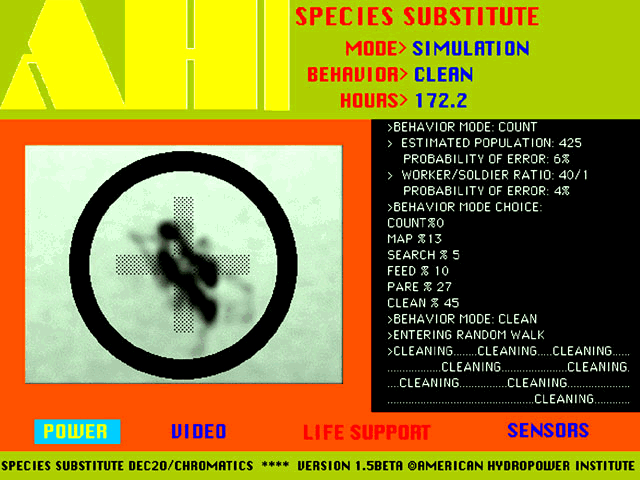1997
Species Substitute
The Species Substitute exhibited at Gallery Otso in Helsinki.
In 1974, American Hydro-power Institute (AHI), a front organization for a variety of energy companies, was faced with a problem. They intended to build a dam in the southwestern United States, but doing so would cause the extinction of a species of ant that lived only in the valleys that were to become flooded. The recent passage of the Endangered Species Act, coupled with a new environmental public awareness, would prevent them from building the dam and achieving tremendous profits which would result.
After preliminary public opinion research, including focus groups and phone surveys, AHI determined that bringing about the extinction would cause their public image, and profits, to suffer. Unfazed, they began initial research into methods for sustaining the ant species in an artificial environment. Drafting computer programmers, electrical engineers, systems coordinators, botanists, and publicists from defense and other industries, AHI settled on a solution that they dubbed the Species Substitute Robot and Artificially Constrained Environment.
A screenshot from a DEC VT241 terminal of the Species Substitute Operator’s Monitor, apparently preparing to enter PARE mode.
In the S.S.R.A.C.E., a large ant colony lived beneath a flat, white, surface, to which they needed to ascend in order to gather food. Waiting for them was the Species Substitute, a clinical looking robot. This robot was equipped with a simple food portion control system, allowing it to drop food at selected locations on the white surface.
The system’s simple luminance-based vision system allowed it to follow and count the ants, calculating the colony's health and rate of reproduction. It scanned the borders of the environment, preventing escapes. It kept track of the piles of food it had just dropped, observing how long it took the ants to move it to the nest. Finally, it monitored environmental parameters, including temperature, humidity, light, and dozens of factors that affected the welfare and behavior of the ants.
Scenes from 1978 AHI promotional video: "Pathways to Progress"
In addition to feeding and nurturing the colony, the robot also emulated the colony's natural predators. By coupling its vision system and navigation system with a termination system (essentially a very bright light and magnifying glass), the Species Substitute would kill individual ants, acting as an effective control of overpopulation. A planned feature would allow the system to alter the evolutionary destiny of the ants, by selecting and eliminating particular behaviors, such as a tendency to move towards picnics.
The working prototype of the Species Substitute was unveiled in 1977, several months before Congress was to decide the fate of the Southwestern dam. They created kiosk-like displays for industry trade shows, and shuttled congressmen from Washington to see the technological marvel. Exceptions to the Endangered Species Act were allowed, and the dam received a green light for construction. Several months later, "insurmountable obstacles" were found in the S.S.R.A.C.E. project, and by 1978 the team had disbanded.
Many of the team's programmers moved to Atari, while the majority of the engineers moved to Martin Marietta to start development on the related Cruise Missile projects. Species Substitute is a powerful metaphor for many technologies, including government. Able both to reward and punish a population that has no essential control over it, some theorists have said it resembles a panopticon, the internet, Amazon Turk, or what other technology is du jour. The kiosk shown at Gallery Otso was a restoration, reconstructed from surviving fragments the original blueprints and functional block diagrams, of the version of the system used in the 1977 Energy Frontiers trade show in Las Vegas.



